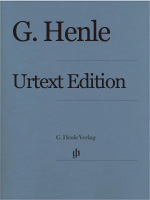Mixed Strings
New Arrivals
Newest Items Listed First
-

-
Poultin, George NEW ITEM!
Aura Lee [w/optional rhythm section] (Naulais)
With optional keyboard and drum set.
Category: String Quartets
Item: 135484
Grade/Level: Intermediate
Price: $28.00
Availability: Ships in 10 to 15 Days - View Shopping Cart
-

-
Gershwin, George NEW ITEM!
Bess, You Is My Woman Now, from Porgy & Bess [w/optional rhythm section] (Naulais)
With optional keyboard and drum set.
Category: String Quartets
Item: 135483
Grade/Level: Intermediate
Price: $28.00
Availability: Ships in 10 to 15 Days - View Shopping Cart
-

-
Traditional NEW ITEM!
Banana Boat Song [w/optional rhythm section] (Naulais)
With optional keyboard and drum set.
Category: String Quartets
Item: 135482
Grade/Level: Intermediate
Price: $28.00
Availability: Ships in 10 to 15 Days - View Shopping Cart
-

-
Various NEW ITEM!
String Quartet Album, v.3 (Naulais)
Stanley: Trumpet Volluntary, Haendel: Arioso, Spiritual: Nobody Knows, Traditional: Il Silenzio, Choral: So Nimm Denn Meine Haende. With optional keyboard and percussion.
Category: String Quartets
Item: 135481
Grade/Level: Intermediate
Price: $34.00
Availability: Ships in 10 to 15 Days - View Shopping Cart
-

-
Various NEW ITEM!
String Quartet Album, v.1 (Naulais)
Bach: Aria, Clarke: Trumpet Voluntary, Pergolesi: Aria, Haendel: March "Scipio," Purcell: Trumpet Tune. With optional keyboard and percussion.
Category: String Quartets
Item: 135480
Grade/Level: Intermediate
Price: $34.00
Availability: Ships in 10 to 15 Days - View Shopping Cart
-

-
Various NEW ITEM!
String Quartet Album, v.2 (Naulais)
Albinoni: Adagio, Gershwin: I Got Rhythm, Beethoven, Die Ehre Gottes aus der Natur, Chopin: Tristesse, Mouret: Fanfare-Rondeau. With optional keyboard and percussion.
Category: String Quartets
Item: 135479
Grade/Level: Intermediate
Price: $34.00
Availability: Ships in 10 to 15 Days - View Shopping Cart
-

-
Various NEW ITEM!
String Quartet Album, v.8 (Naulais)
Borodine: Polovetzian Dance, Haendel: Minuet, Armitage: Four Fanfares, Bach-Gounod: Ave Maria, and Joshua Fit the Battle of Jericho. With optional keyboard and percussion.
Category: String Quartets
Item: 135478
Grade/Level: Intermediate
Price: $34.00
Availability: Ships in 10 to 15 Days - View Shopping Cart
-

-
Various NEW ITEM!
String Quartet Album, v.4 (Naulais)
Schubert: Serenade, Gershwin: S'Wonderful, Dvorak: Humoresque, Haendel: Sarabande I, and Greensleeves. With optional keyboard and percussion.
Category: String Quartets
Item: 135477
Grade/Level: Intermediate
Price: $34.00
Availability: Ships in 10 to 15 Days - View Shopping Cart
-

-
Bartok, Bela NEW ITEM!
String Quartet No 1 in Am, op 7 (1909) [set of parts] (Somfai/Nemeth)
B‚la Bart˘k's six string quartets, composed between 1908 and 1940, are 20th-century milestones of the genre. His First String Quartet is closely linked to his unhappy love for the violinist Stefi Geyer, to whom he sent the initial measures of its first movement in early 1908 with the remark: "My song of death." When he completed all three movements of the work a year later, he had, according to his friend and colleague Zolt n Kod ly, written himself "back into life," In this First Quartet, Bart˘k...
Read More
Category: String Quartets
Item: 135196
Grade/Level: Advanced
Price: $30.95
Availability: Usually Ships in 24 Hours - View Shopping Cart
-

-
Dvorak, Antonin NEW ITEM!
Piano Quartet in Eb, op 87 (Jost/Leuschner)
For several years following composition of his first piano quartet, Dvor k's publisher Simrock pushed him to compose a follow-up piece in the genre. The work, written during a few short weeks in summer 1889, fulfilled Simrocks wishes. With his op. 87, Dvor k delivered a challenging and mature work in which a mastery of form is combined with memorable themes and surprising harmonic turns, leading it quickly to conquer the hearts of both performers and audiences.The engraver's model for the fi...
Read More
Category: Piano Quartets
Item: 135195
Grade/Level: Advanced
Price: $34.95
Availability: Usually Ships in 24 Hours - View Shopping Cart
-

-
Bartok, Bela NEW ITEM!
String Quartet No 2, op 17 (1920) [set of parts] (Somfai/Nemeth)
Bart˘k's Second String Quartet was composed with several long interruptions between 1915 and 1918, after he had spent several years almost solely devoted to collecting folk music. The melody and rhythms of the riotous middle movement "Allegro, molto capriccioso" provide impressive testimony of how his research trips had taken him as far as North Africa. The first edition of this quartet, published in Vienna in 1920, contains a conspicuous number of errors that were only partially corrected in a...
Read More
Category: String Quartets
Item: 135194
Grade/Level: Advanced
Price: $30.95
Availability: Usually Ships in 24 Hours - View Shopping Cart
-

-
Bartok, Bela NEW ITEM!
String Quartet No 2, op 17 (1920) [study score] (Somfai/Nemeth)
Bartok's Second String Quartet was composed with several long interruptions between 1915 and 1918, after he had spent several years almost solely devoted to collecting folk music. The melody and rhythms of the riotous middle movement "Allegro, molto capriccioso" provide impressive testimony of how his research trips had taken him as far as North Africa. The first edition of this quartet, published in Vienna in 1920, contains a conspicuous number of errors that were only partially corrected in a...
Read More
Category: String Quartets
Item: 135191
Grade/Level: Advanced
Price: $17.95
Availability: Usually Ships in 24 Hours - View Shopping Cart
-

-
Bartok, Bela NEW ITEM!
String Quartet No 1 in Am, op 7 (1909) [study score] (Somfai)
Bela Bartok's six string quartets, composed between 1908 and 1940, are 20th-century milestones of the genre. His First String Quartet is closely linked to his unhappy love for the violinist Stefi Geyer, to whom he sent the initial measures of its first movement in early 1908 with the remark: "My song of death." When he completed all three movements of the work a year later, he had, according to his friend and colleague Zolt n Kod ly, written himself "back into life." In this First Quartet, Bartok...
Read More
Category: String Quartets
Item: 135190
Grade/Level: Advanced
Price: $17.95
Availability: Usually Ships in 24 Hours - View Shopping Cart
